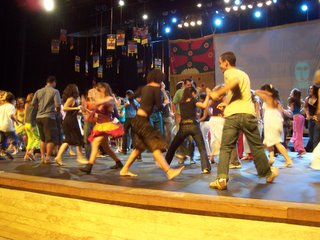... two nations between whom there is no intercourse an no sympathy; who are ignorant of each other's habits, thoughts and feelings as if they were dwellers in different zones or inhabitants of different planets... the rich and the poor
- Benjamin Disraeli, English Statesman, Author, Prime Minister,
describing 1840s Britain in the novel Sybil.
Every year, the United Nations Development Programme comes out with the Human Development Index (HDI), a list that ranks countries in descending order of quality of life, using factors such as life expectancy at birth, literacy rates, and GDP per capita. An HDI of 1 denotes a maximum level of human development while a score of 0 denotes a complete lack of human development.
According to the most recent ranking, Brazil ranks 63rd out of 177 countries ranked. Not too bad, considering the fact that Brazil is a middle-income country which has the world’s 5th largest land mass, 5th largest population base [180 million] and 14th largest economy. But as always, the problem with statistics is that they can conceal, gloss-over, generalize, and otherwise obscure [sorry P-Bay!] extreme situations. There are in fact many Brazils and many HDIs within the country’s borders and these Brazils can be divided by region – South/Southeast vs. North/Northeast; by colour – European descent vs. African descent; by gender – male vs. female; and by age – working age vs. youth, among other distinctions. When the HDI for subcategories are examined, the results tend to shock.
In terms of regional differences, the south and southeastern states all have higher HDI rankings than the north and northeastern states. While there is no question that Brazil has made tremendous social gains in the past fifty years [e.g.: infant mortality has dropped dramatically, school enrolment is at virtually 100%, and literacy rates are much higher than they were only a few decades ago], overall gains have not succeeded in diminishing the gap between the haves and the have-nots. The following table shows both the recent gains made in Brazil as well as the fact that the inequities continue.
| Ranking | State | HDI |
|---|
| 1991 | 2000 |
|---|
| Brazil | 0.696 | 0.766 |
| 1 | Distrito Federal (Brasilia) | 0.799 | 0.844 |
| 2 | Santa Catarina | 0.748 | 0.822 |
| 3 | São Paulo | 0.778 | 0.820 |
| 4 | Rio Grande do Sul | 0.753 | 0.814 |
| 5 | Rio de Janeiro | 0.753 | 0.807 |
| 6 | Paraná | 0.711 | 0.787 |
| ... | ... | ... | ... |
| 18 | Pernambuco | 0.620 | 0.705 |
| ... | ... | ... | ... |
| 22 | Bahia | 0.590 | 0.688 |
| 23 | Sergipe | 0.597 | 0.682 |
| 24 | Paraiba | 0.0.561 | 0.661 |
| 25 | Piaui | 0.566 | 0.656 |
| 26 | Alagoas | 0.548 | 0.649 |
| 27 | Maranhão | 0.543 | 0.636 |
Aside from Brasilia [whose ranking only includes Brasilia proper and not its "satellite" cites where the majority of Brasilia's non-middle and upper classes live], all the top spots are occupied by states in Brazil's more industrialised south and southeast while all the bottom spots are occupied by states in the Northeast. In terms of ethnic differences, the rankings are similar. If Brazilians of European descent and those of African descent were ranked separately, they would occupy the 44th and 105th spots respectively of the global ranking, a difference of 61 positions. In another illustration, per capita income for Brazil's white population in 1980 was 110 percent higher than Brazil's black population per capita income in 2000. To be fair, the HDI ranking for Brazil's black population increased more than it did for Brazil's European population in the last two decades. However, it is clear that the gap is still wide.
One City, Many Recifes
 As a metropolitan state capital in Brazil’s Northeast, Recife is not immune to any of these extremes. Back in December, the city launched a city-level Human Development Atlas which divided the city into 62 different neighbourhoods or bairros and calculated the HDI for each. The results put the following neighbourhoods in the following positions:
As a metropolitan state capital in Brazil’s Northeast, Recife is not immune to any of these extremes. Back in December, the city launched a city-level Human Development Atlas which divided the city into 62 different neighbourhoods or bairros and calculated the HDI for each. The results put the following neighbourhoods in the following positions:
| Neighbourhood | HDI | Global Comparison¹ |
|---|
| Boa Viagem / Pina | 0.964 | Norway |
| Graças / Aflitos / Derby / Espinheiro | 0.953 | Luxembourg / Australia |
| Casa Forte / Parnamirim / Jaquiera / Monteiro | 0.933 | Japan |
| ... | ... | ... |
| Brejos da Guabiraba e de Beberibe | 0.668 | Honduras |
| Santo Amaro | 0.658 | South Africa |
| Joana Bezerra / São José (Coque) | 0.632 | Morocco / Gabon |
Perversely enough, Boa Viagem and Pina’s score would have probably even been a smidgen higher except for the fact that even these neighbourhoods are not free from the favelas – informal, precarious, low-income settlements – that permeate Brazil.
Although many of the neighbourhoods with the lowest HDI rankings are often in the peripheries or margins of the city, a large number are also right in the centre of it all. Joana Bezerra, Coque and Coelho, the city’s poorest and most violent neighbourhoods back right onto Pina and its neighbour Boa Viagem. What is sad is that the richer neighbourhoods’ reaction to its own proximity to poorer neighbourhoods is not always to try and find solutions to these immense gaps², but rather to put up more barriers, hire more private security guards, keep more store doors locked during business hours, and raise the levels of both physical and psychological fences.
¹ Yes, I realise that I am comparing disaggregated to aggregated data, probably a serious no-no in statistical analysis!
² Fortunately many solution-searchers [and finders and implementers] do also exist, as I hope that my blog ultimately shows.


















